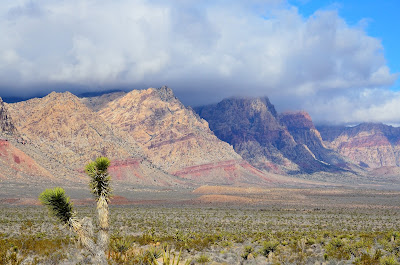Clark County Commissioners seem intent on approving more urban sprawl in the Las Vegas Valley at a meeting on
February 7. On the meeting's agenda is a
plan by Gypsum Resources to build a nearly 5,000-home community on top of Blue Diamond Hill on the edge of
Red Rock Canyon National Conservation Area, a popular outdoor escape near Las Vegas, Nevada. The County Commissioners have been advised by their own planning commission
not to approve the project because the development would be a significant departure from the county's original master plan that requires the area remain low-density and rural.
 |
| Red Rock Canyon National Conservation Area offers excellent hiking, camping, rock climbing, and cycling opportunities amidst stunning scenery for visitors and residents of nearby Las Vegas. |
The County is
suing a grassroots community group opposed to the Blue Diamond Hill sprawl in an effort to undermine opposition to the plans, suggesting the County Commissioners are on the side of the developer. If built, the tract homes and businesses would be visible to visitors at Red Rock Canyon, increase light pollution, and add significant traffic congestion to nearby roads that are not designed to accommodate the proposed new population. The Save Red Rock Canyon coalition enumerates the many other problems with the Blue Diamond Hill plan on their
website.
 |
| The proposed development - in yellow - would have an "edge effect" on surrounding public lands, eroding the quality of wildlife habitat and encouraging even more sprawl. Image from development plans submitted to Clark County. [click on image to expand] |
The County's intent to re-zone the nearly four square miles of land from rural to higher density seems unwise because of the development's location on the edge of the Las Vegas Valley. Adding thousands of people at the fringe of the Las Vegas Valley would mean thousands of more cars on the roads, with residents driving further to reach jobs closer to the center of the metropolitan area. The development would also require the allocation of more county resources - such as police, fire, new schools, etc. - than would otherwise be necessary if the population increase occurred closer to the city center where services could be augmented more efficiently and at less cost.
 |
| Map: Save Red Rock Canyon Coalition |
Sprawl begets sprawl and approval of the Blue Diamond Hill development is likely to result in increased pressure on the Federal government to "dispose" of the adjacent public lands to accommodate even more development. The construction of 5,000 homes next to public lands will have an edge effect that erodes the quality of the wildlife habitat on those lands. Less biodiversity, more invasive species and soil erosion are examples of conditions likely to befall habitat immediately adjacent to human development. Much of the land surrounding the Blue Diamond Hill development is public land, but an erosion of habitat quality on the adjacent public lands may become an excuse by political leaders and land managers to relinquish the public land to developers.
Congress and the Bureau of Land Management (BLM) have already identified other parcels of public lands around the Las Vegas Valley for such disposal. The
Southern Nevada Land Management Act of 1998 directed the BLM to sell public land within a specific boundary around Las Vegas for private development. The law was amended in 2002 to expand the boundary and add thousands of more acres of public lands to be eligible for future "disposal." With pressure by some political leaders to
transfer millions of acres of public lands to the state for development, it's likely that we will see additional adjustments to the Las Vegas "disposal boundary" that could facilitate further urban sprawl.
So the proposed development at Blue Diamond Hill should not be viewed as an isolated proposal, but as part of a chain reaction that is already in motion. It is a high-density development at the edge of the Las Vegas Valley that will only serve as an anchor to encourage further sprawl. Stopping this chain reaction of sprawl will require smarter planning by our local governments and the rejection of this development by the Clark County Commissioners.






Comments
Post a Comment